Attached files
| file | filename |
|---|---|
| 8-K - FORM 8-K - MOLINA HEALTHCARE, INC. | a60122e8vk.htm |
Exhibit 99.1

| New York, New York September 15, 2011 INVESTOR DAY 2011B |
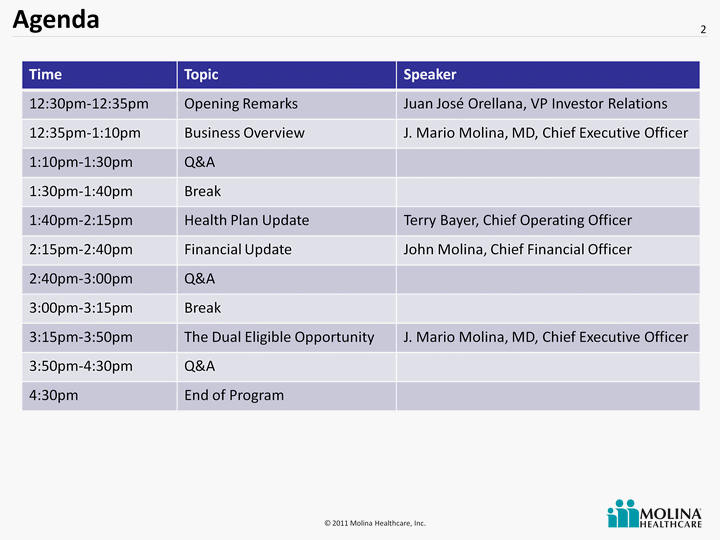
| Agenda Agenda 2 |
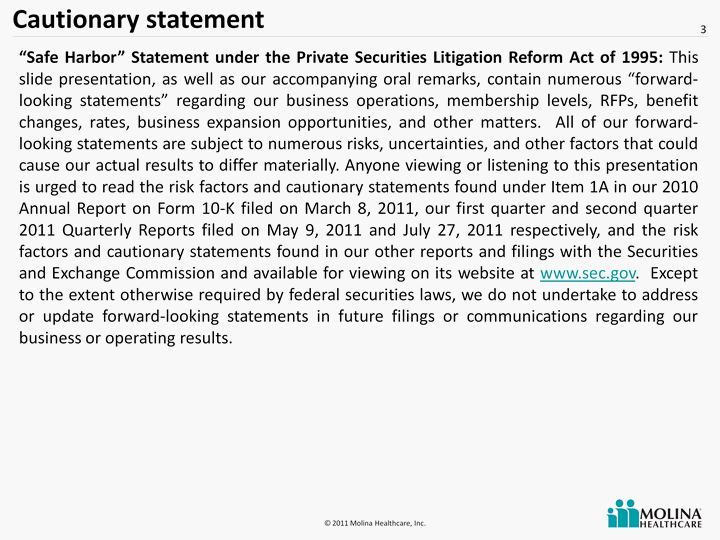
| Cautionary statement "Safe Harbor" Statement under the Private Securities Litigation Reform Act of 1995: This slide presentation, as well as our accompanying oral remarks, contain numerous "forward- looking statements" regarding our business operations, membership levels, RFPs, benefit changes, rates, business expansion opportunities, and other matters. All of our forward- looking statements are subject to numerous risks, uncertainties, and other factors that could cause our actual results to differ materially. Anyone viewing or listening to this presentation is urged to read the risk factors and cautionary statements found under Item 1A in our 2010 Annual Report on Form 10-K filed on March 8, 2011, our first quarter and second quarter 2011 Quarterly Reports filed on May 9, 2011 and July 27, 2011 respectively, and the risk factors and cautionary statements found in our other reports and filings with the Securities and Exchange Commission and available for viewing on its website at www.sec.gov. Except to the extent otherwise required by federal securities laws, we do not undertake to address or update forward-looking statements in future filings or communications regarding our business or operating results. 3 |

| New York, New York September 15, 2011 Business Overview J. Mario Molina, MD President & Chief Executive Officer |
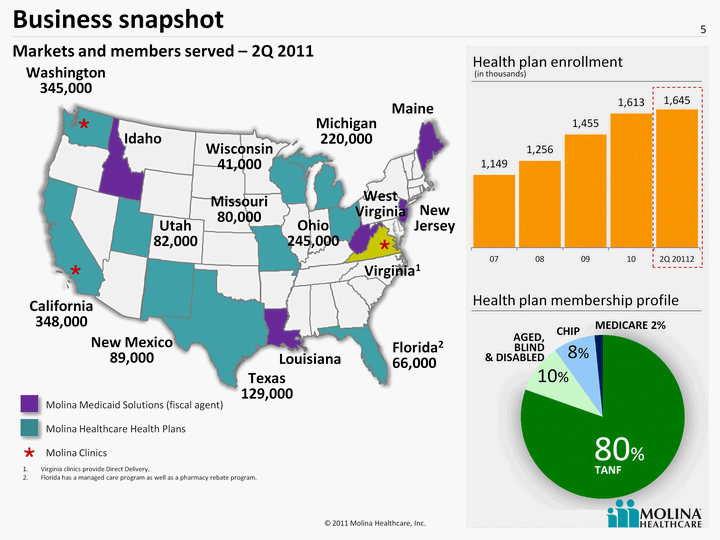
| Business snapshot Markets and members served - 2Q 2011 Washington 345,000 California 348,000 New Mexico 89,000 Utah 82,000 Texas 129,000 Missouri 80,000 Michigan 220,000 Ohio 245,000 Florida2 66,000 Health plan enrollment Health plan membership profile (in thousands) Molina Healthcare Health Plans Molina Medicaid Solutions (fiscal agent) Idaho Maine Louisiana West Virginia New Jersey Virginia clinics provide Direct Delivery. Florida has a managed care program as well as a pharmacy rebate program. Virginia1 Wisconsin 41,000 (CHART) AGED, BLIND & DISABLED MEDICARE 2% 80% TANF 10% CHIP 8% 5 (CHART) ? ? ? ? Molina Clinics |

| Quality and value 6 |

| Health care reform update Medicaid Provisions (all in effect) include: Center for Medicare and Medicaid Innovation Medicaid Health Homes Chronic Disease Prevention Medicaid Payments for Hospital-Acquired Infections Medicaid Long-Term Care Services 18 of 21 of the 2011 provisions of the Affordable Care Act (ACA) are in effect Source: Kaiser Family Foundation (http://healthreform.kff.org/timeline.aspx) 7 |

| Health care reform update CMS issued draft regulations on the creation of state-based health insurance exchanges, giving states broad flexibility to create their insurance marketplace by 2014. Only three Molina MCO states have enacted legislation regarding health insurance exchanges as of today. West Virginia is the only Molina Medicaid Solutions state to have enacted authorizing Exchange legislation. Under the Affordable Care Act (ACA), eligibility determinations for both the Exchange and Medicaid must be seamless and the portals will operate in tandem beginning in 2014. Federal district and circuit courts are divided regarding individual mandate. U.S. Supreme Court review next summer appears likely. (11th Circuit ruled the individual mandate unconstitutional and the 4th and 6th Circuits ruled to uphold the individual mandate.) 8 |
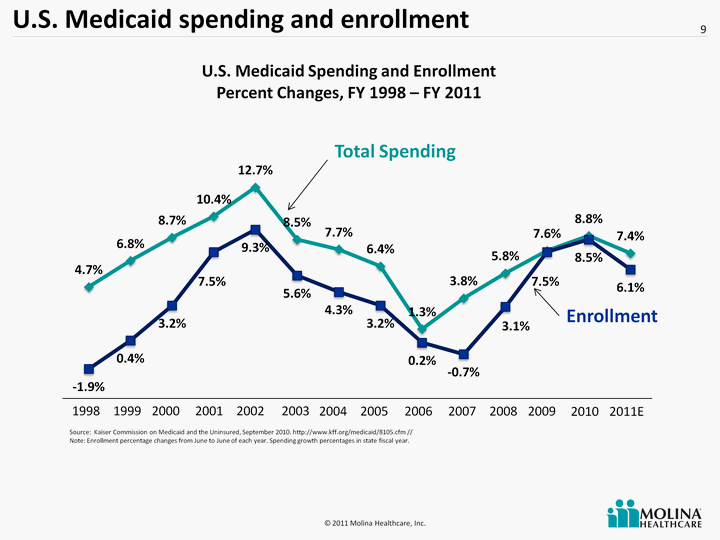
| U.S. Medicaid Spending and Enrollment Percent Changes, FY 1998 - FY 2011 (CHART) Source: Kaiser Commission on Medicaid and the Uninsured, September 2010. http://www.kff.org/medicaid/8105.cfm // Note: Enrollment percentage changes from June to June of each year. Spending growth percentages in state fiscal year. Total Spending Enrollment U.S. Medicaid spending and enrollment 9 1998 1999 2000 2001 2002 2003 2004 2005 2006 2007 2008 2009 2010 2011E |

| Annual Percentage Changes 2007 - 2020 (Projected) 2007 - 2020 (Projected) 2007 - 2020 (Projected) 10 Source: Percentages compiled by Health Management Associates (HMA) based on data from CMS Office of Actuary, August 2011. End of Enhanced FMAP State share of Medicaid spending is growing Average Annual Rate of Growth 2013 to 2020 = 7.9% % Change in Spending |
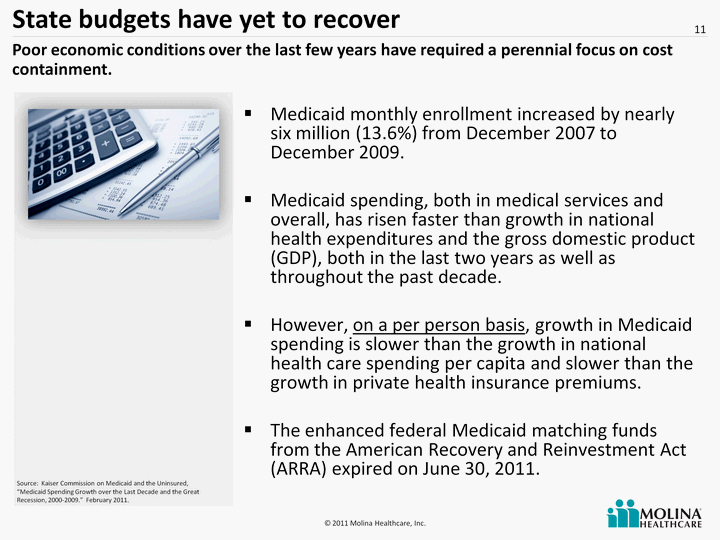
| Medicaid monthly enrollment increased by nearly six million (13.6%) from December 2007 to December 2009. Medicaid spending, both in medical services and overall, has risen faster than growth in national health expenditures and the gross domestic product (GDP), both in the last two years as well as throughout the past decade. However, on a per person basis, growth in Medicaid spending is slower than the growth in national health care spending per capita and slower than the growth in private health insurance premiums. The enhanced federal Medicaid matching funds from the American Recovery and Reinvestment Act (ARRA) expired on June 30, 2011. 11 Poor economic conditions over the last few years have required a perennial focus on cost containment. State budgets have yet to recover 11 Source: Kaiser Commission on Medicaid and the Uninsured, "Medicaid Spending Growth over the Last Decade and the Great Recession, 2000-2009." February 2011. |
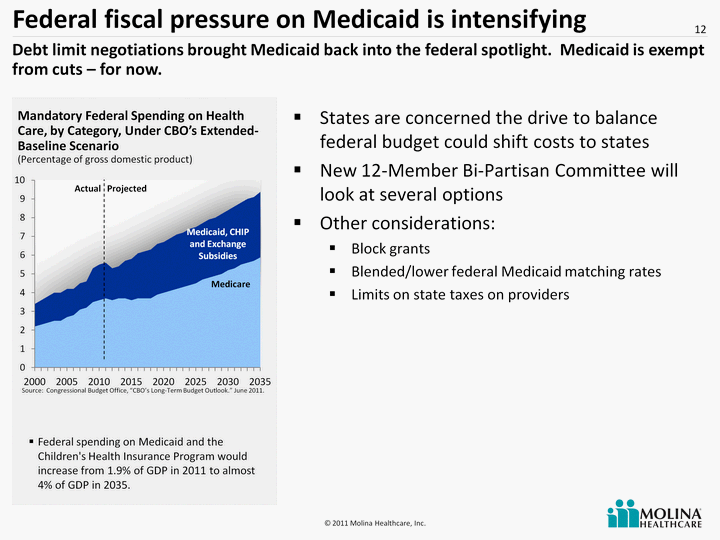
| Federal fiscal pressure on Medicaid is intensifying States are concerned the drive to balance federal budget could shift costs to states New 12-Member Bi-Partisan Committee will look at several options Other considerations: Block grants Blended/lower federal Medicaid matching rates Limits on state taxes on providers 12 Federal spending on Medicaid and the Children's Health Insurance Program would increase from 1.9% of GDP in 2011 to almost 4% of GDP in 2035. Source: Congressional Budget Office, "CBO's Long-Term Budget Outlook." June 2011. (CHART) Medicaid, CHIP and Exchange Subsidies Medicare Actual Projected Mandatory Federal Spending on Health Care, by Category, Under CBO's Extended- Baseline Scenario (Percentage of gross domestic product) Debt limit negotiations brought Medicaid back into the federal spotlight. Medicaid is exempt from cuts - for now. |
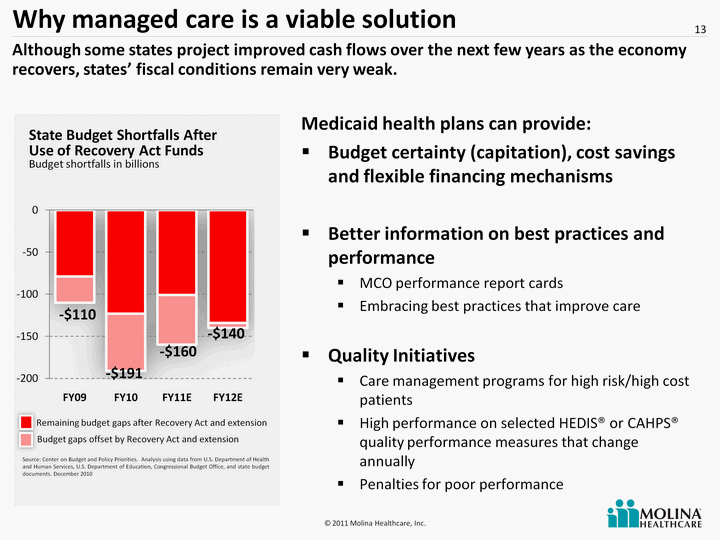
| Why managed care is a viable solution Although some states project improved cash flows over the next few years as the economy recovers, states' fiscal conditions remain very weak. (CHART) -$110 -$191 -$160 -$140 State Budget Shortfalls After Use of Recovery Act Funds Budget shortfalls in billions Source: Center on Budget and Policy Priorities. Analysis using data from U.S. Department of Health and Human Services, U.S. Department of Education, Congressional Budget Office, and state budget documents. December 2010 Budget gaps offset by Recovery Act and extension Remaining budget gaps after Recovery Act and extension 13 Medicaid health plans can provide: Budget certainty (capitation), cost savings and flexible financing mechanisms Better information on best practices and performance MCO performance report cards Embracing best practices that improve care Quality Initiatives Care management programs for high risk/high cost patients High performance on selected HEDIS(r) or CAHPS(r) quality performance measures that change annually Penalties for poor performance |

| Q&A 14 |

| New York, New York September 15, 2011 Health Plan Update Terry P. Bayer Chief Operating Officer |

| California 16 Good performance continues Consolidated and redirected services to lower cost, more efficient providers Continued growth in Special Persons with Disabilities (California term for ABDs) Enrollment in mandatory managed care began in June 2011 State budget - provider rate cut pending (CHART) (CHART) Molina Healthcare of California Historical and YTD Enrollment 2007-2Q2011 Molina Healthcare of California Historical and MCR 2007-2Q2011 |
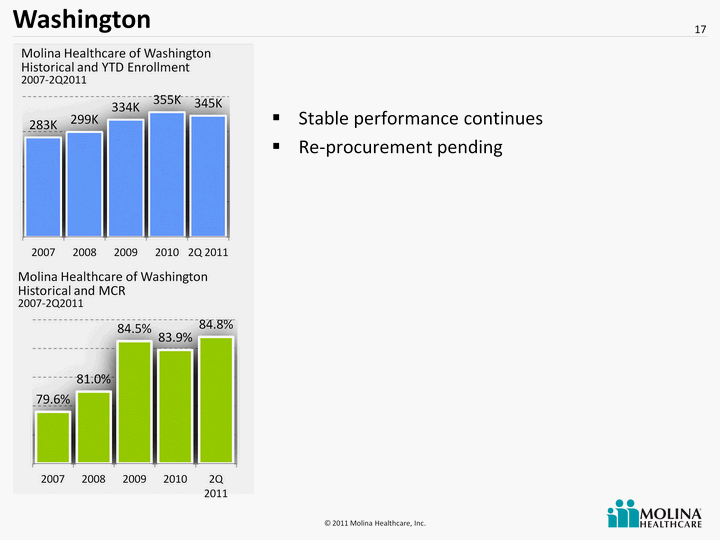
| Washington 17 Stable performance continues Re-procurement pending (CHART) (CHART) Molina Healthcare of Washington Historical and YTD Enrollment 2007-2Q2011 Molina Healthcare of Washington Historical and MCR 2007-2Q2011 |
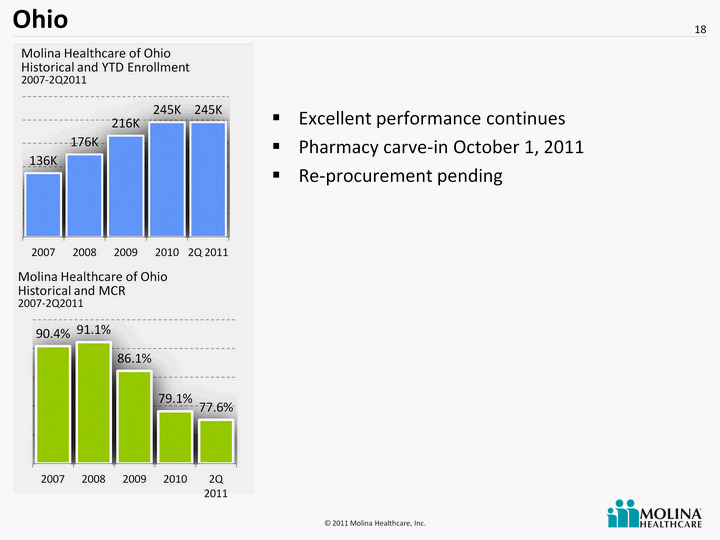
| Ohio 18 Excellent performance continues Pharmacy carve-in October 1, 2011 Re-procurement pending (CHART) (CHART) Molina Healthcare of Ohio Historical and YTD Enrollment 2007-2Q2011 Molina Healthcare of Ohio Historical and MCR 2007-2Q2011 |

| Michigan 19 Medical cost control continues "Excellent" NCQA accreditation 6,500 Medicare SNP members as foundation for future dual eligible expansion (CHART) (CHART) Molina Healthcare of Michigan Historical and YTD Enrollment 2007-2Q2011 Molina Healthcare of Michigan Historical and MCR 2007-2Q2011 |
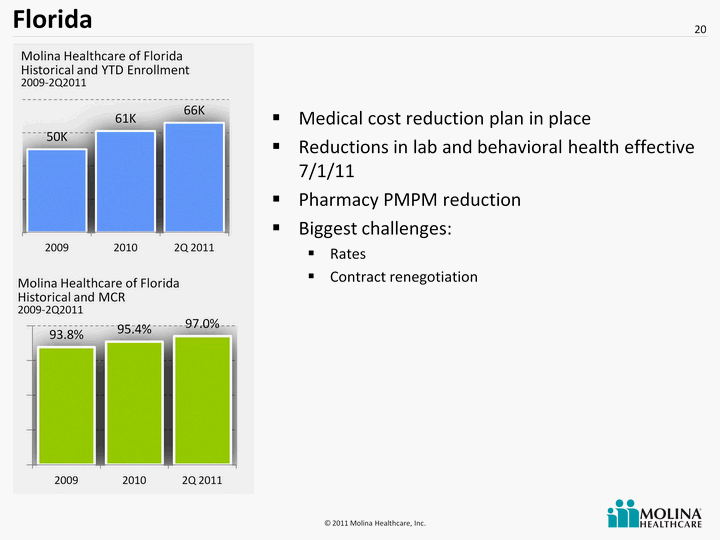
| Florida Medical cost reduction plan in place Reductions in lab and behavioral health effective 7/1/11 Pharmacy PMPM reduction Biggest challenges: Rates Contract renegotiation 20 (CHART) (CHART) Molina Healthcare of Florida Historical and YTD Enrollment 2009-2Q2011 Molina Healthcare of Florida Historical and MCR 2009-2Q2011 |
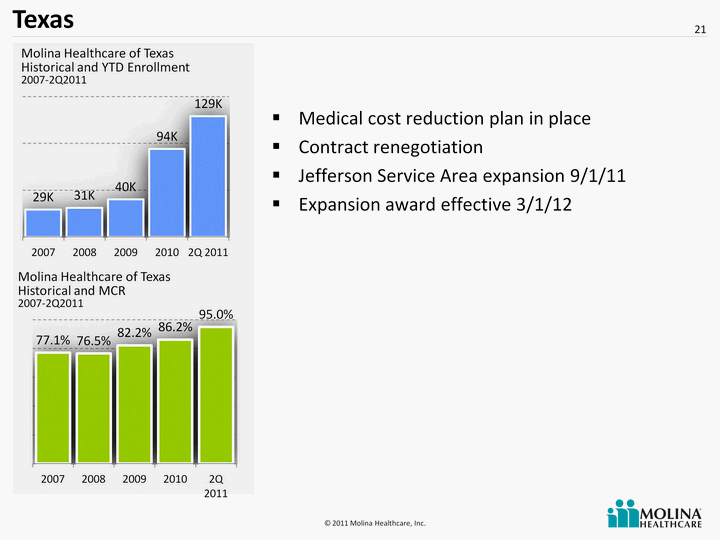
| Texas 21 Medical cost reduction plan in place Contract renegotiation Jefferson Service Area expansion 9/1/11 Expansion award effective 3/1/12 (CHART) (CHART) Molina Healthcare of Texas Historical and YTD Enrollment 2007-2Q2011 Molina Healthcare of Texas Historical and MCR 2007-2Q2011 |
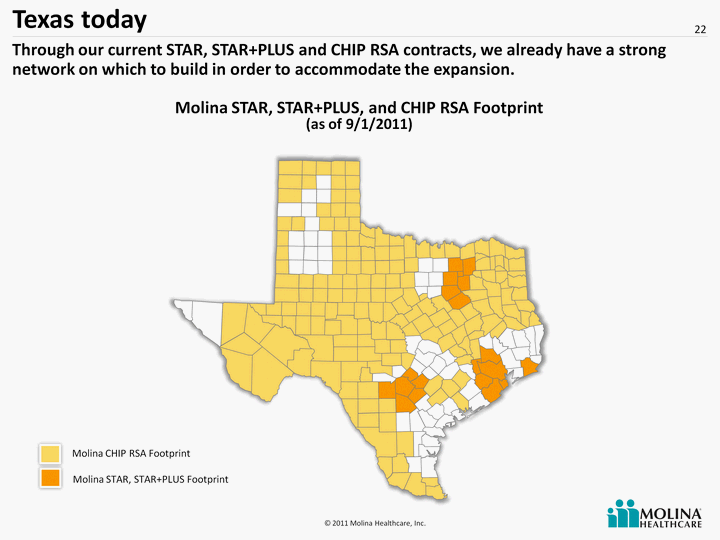
| Texas today Through our current STAR, STAR+PLUS and CHIP RSA contracts, we already have a strong network on which to build in order to accommodate the expansion. Molina STAR, STAR+PLUS, and CHIP RSA Footprint (as of 9/1/2011) Molina CHIP RSA Footprint Molina STAR, STAR+PLUS Footprint 22 |

| Texas win overview Molina CHIP RSA Footprint 23 Bexar Service Area STAR+PLUS Dallas Service Area STAR (new) STAR+PLUS CHIP (new) El Paso Service Area STAR+PLUS (new) STAR (new) Harris Service Area STAR+PLUS STAR CHIP Hidalgo Service Area STAR+PLUS (new) STAR (new) CHIP RSA Jefferson Service Area STAR+PLUS (new) STAR (new) CHIP (new) Molina STAR, STAR+PLUS, CHIP Expansion & re- procurement counties and eligible members. Molina has been awarded a tentative contract by the State of Texas for a re-procurement and expansion of its STAR (TANF), STAR+PLUS (ABD), and CHIP Medicaid programs covering 3.4 million eligibles. Source: Texas Health and Human Services Commission http://www.hhsc.state.tx.us/medicaid/MMC-Contiguous-Counties.pdf http://www.hhsc.state.tx.us/contract/529120002/announcements.shtml Molina Footprint After 2011 Re-procurement Awards |

| Texas win overview 24 MOH IR DayJan 2011 Revised Sept 2011 Total Covered Population 3.4M 3.4M Population Up for Bid 3.2M 3.2M Effective Date 3/12 3/12 MOH Expected Membership Prior to Expansion1 125K 150K MOH Expected Additional Membership2 220K 220K Total Expected MOH Membership2 345K 370K MOH Expected Market Penetration2 10% 11% MOH Expected Incremental Annualized Revenue3 $663M $660M Please refer to the Company's cautionary statement. Denotes estimated membership at 12/31/11 Denotes estimated membership at 3/1/12 Excludes impact of Rx and Inpatient carve in effective 3/1/12 Note: Amounts are estimates and subject to change |
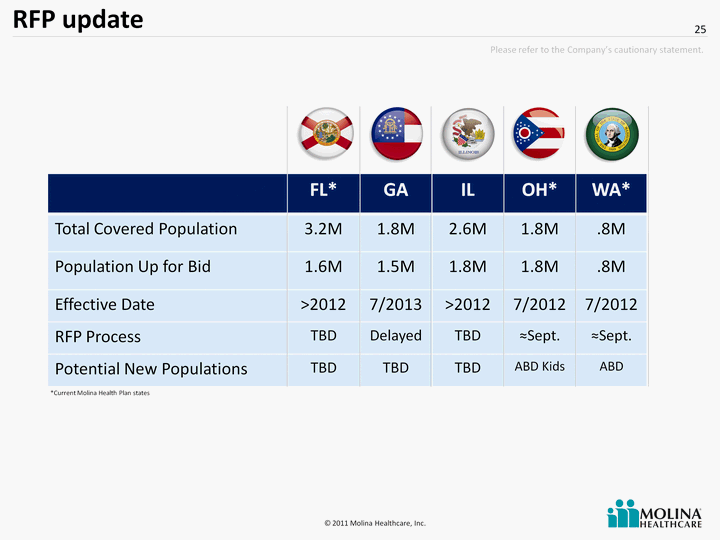
| RFP update 25 FL* GA IL OH* WA* Total Covered Population 3.2M 1.8M 2.6M 1.8M .8M Population Up for Bid 1.6M 1.5M 1.8M 1.8M .8M Effective Date >2012 7/2013 >2012 7/2012 7/2012 RFP Process TBD Delayed TBD ^Sept. ^Sept. Potential New Populations TBD TBD TBD ABD Kids ABD Please refer to the Company's cautionary statement. *Current Molina Health Plan states |
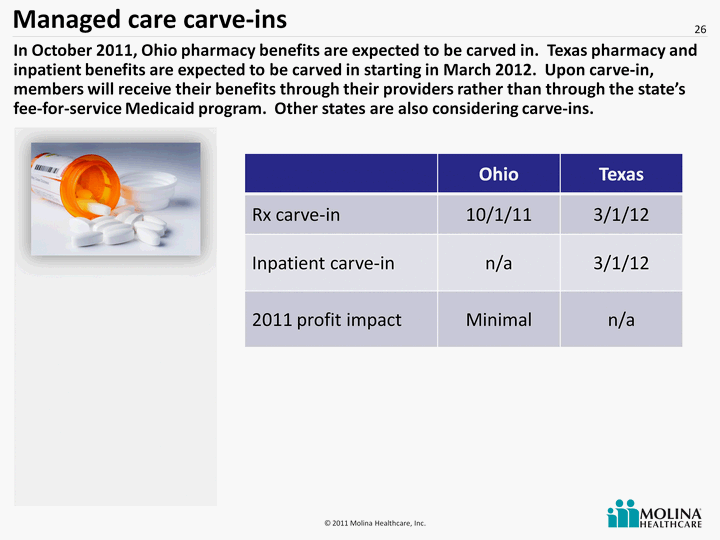
| Managed care carve-ins 26 In October 2011, Ohio pharmacy benefits are expected to be carved in. Texas pharmacy and inpatient benefits are expected to be carved in starting in March 2012. Upon carve-in, members will receive their benefits through their providers rather than through the state's fee-for-service Medicaid program. Other states are also considering carve-ins. Ohio Texas Rx carve-in 10/1/11 3/1/12 Inpatient carve-in n/a 3/1/12 2011 profit impact Minimal n/a |
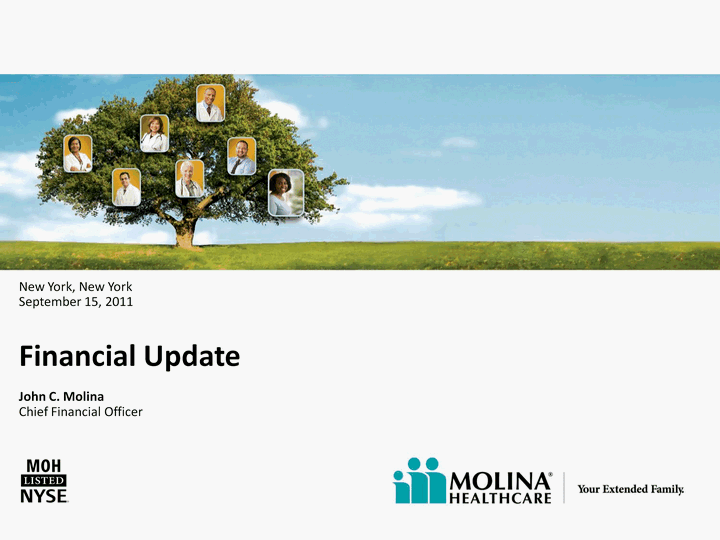
| New York, New York September 15, 2011 Financial Update John C. Molina Chief Financial Officer |

| Rate update 28 Health Plan Date Revenue Impact1 California (10% provider rate cut) 7/1/2011 (^6.0%) Florida 9/1/2011 unknown Michigan 10/1/2011 unknown Missouri 7/1/2011 ^5.0% New Mexico 7/1/2011 (^2.5%) Ohio 1/1/2012 unknown Texas 9/1/2011 (^2.0%) Utah 7/1/2011 (^2.0%) Washington 10/1/2011 unknown Wisconsin 1/1/2012 unknown Please refer to the Company's cautionary statement. 1. "( )" indicates a negative revenue impact |

| 29 2Q 2010 Premium Revenue Service Revenue Investment Income Medical Care Costs Medical Care Ratio Service Costs G&A Expense G&A Ratio Premium Tax Expense Depreciation and Amortization Interest Expense Income Before Tax Income Tax Net Income Diluted EPS Weighted Average Diluted Shares Outstanding EBITDA Effective Tax Rate $977M $21M $1.6M $839.6M 86.0% $14.3M $78M 7.8% $35.0M $11.2M $4M $17.1M $6.5M $10.6M $0.27 38.9M $35.0M 38% Please refer to the Company's cautionary statement. 2Q 2011 $1.1B $37M $1.4M $949.4M 84.1% $39.2M $97M 8.3% $37.7M $12.5M $4M $27.7M $10.3M $17.4M $0.38 46.5M $47.9M 37% Change $123M $16M ($0.4M) $109.8M (1.9%) $24.9M $19M 0.5% $2.2M $1.3M $0M $10.6M $3.8M $6.8M $0.11 7.6M $12.9M (1%) Financial results |

| 2011 guidance 30 Strong performance of established health plans & fiscal agents Earlier than anticipated utilization improvements Improvement in fiscal agent business expected in second half of 2011 Premium rate reductions Cost challenges in Texas and Florida health plans $1.55 Guidance Issued Jul 21, 2011 $1.47*Guidance Issued Jan 26, 2011 * Note: EPS guidance issued 1/26/11 has been adjusted to reflect 3 for 2 stock split effective 5/9/11 Please refer to the Company's cautionary statement. |
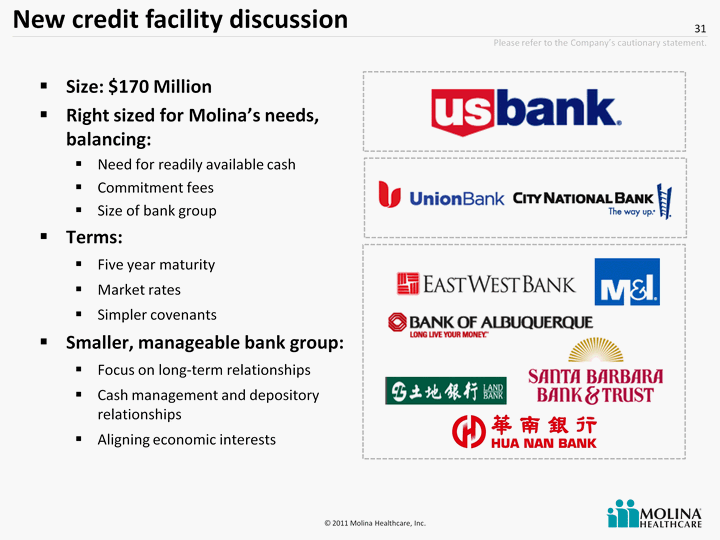
| New credit facility discussion Size: $170 Million Right sized for Molina's needs, balancing: Need for readily available cash Commitment fees Size of bank group Terms: Five year maturity Market rates Simpler covenants Smaller, manageable bank group: Focus on long-term relationships Cash management and depository relationships Aligning economic interests 31 Please refer to the Company's cautionary statement. |
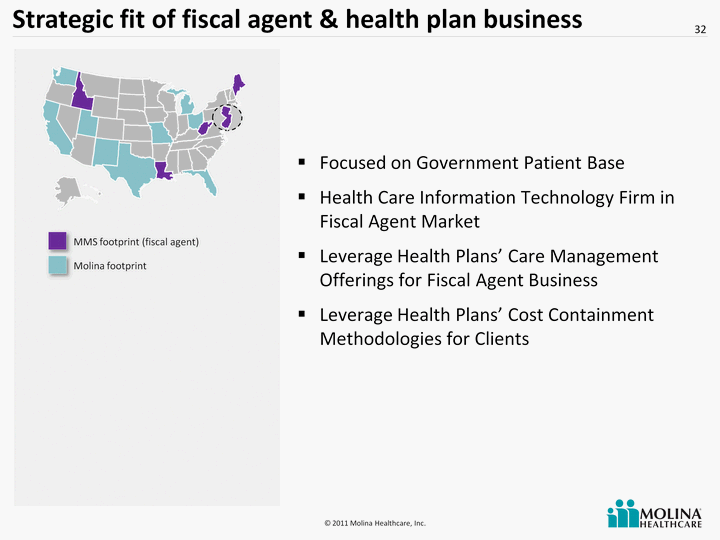
| Strategic fit of fiscal agent & health plan business Focused on Government Patient Base Health Care Information Technology Firm in Fiscal Agent Market Leverage Health Plans' Care Management Offerings for Fiscal Agent Business Leverage Health Plans' Cost Containment Methodologies for Clients 32 Molina footprint MMS footprint (fiscal agent) |
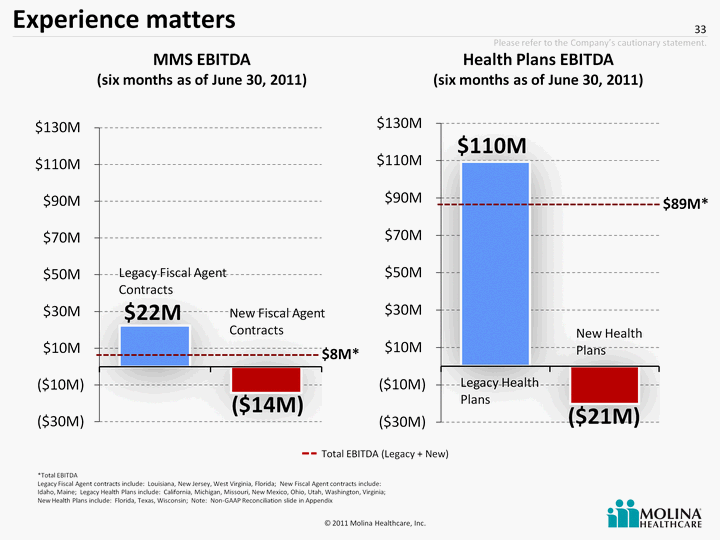
| Experience matters Experience matters 33 MMS EBITDA (six months as of June 30, 2011) (six months as of June 30, 2011) (six months as of June 30, 2011) Health Plans EBITDA (six months as of June 30, 2011) $8M* *Total EBITDA Legacy Fiscal Agent contracts include: Louisiana, New Jersey, West Virginia, Florida; New Fiscal Agent contracts include: Idaho, Maine; Legacy Health Plans include: California, Michigan, Missouri, New Mexico, Ohio, Utah, Washington, Virginia; New Health Plans include: Florida, Texas, Wisconsin; Note: Non-GAAP Reconciliation slide in Appendix $110M ($21M) $22M ($14M) $89M* Total EBITDA (Legacy + New) Legacy Fiscal Agent Contracts New Fiscal Agent Contracts Legacy Health Plans New Health Plans Please refer to the Company's cautionary statement. |

| Experience matters Experience matters 34 TOTAL MOLINA EBITDA (six months as of June 30, 2011) $97M* $132M ($35M) Total EBITDA (Legacy + New) MOH Legacy MOH New Please refer to the Company's cautionary statement. *Total EBITDA MOH Legacy includes: Health Plans in California, Michigan, Missouri, New Mexico, Ohio, Utah, Washington, Virginia, & Fiscal Agents contracts in Louisiana, New Jersey, West Virginia, and Florida; MOH New includes: Health Plans in Florida, Texas, Wisconsin & Fiscal Agent contracts in Idaho and Maine ; Note: Non-GAAP Reconciliation slide in Appendix |
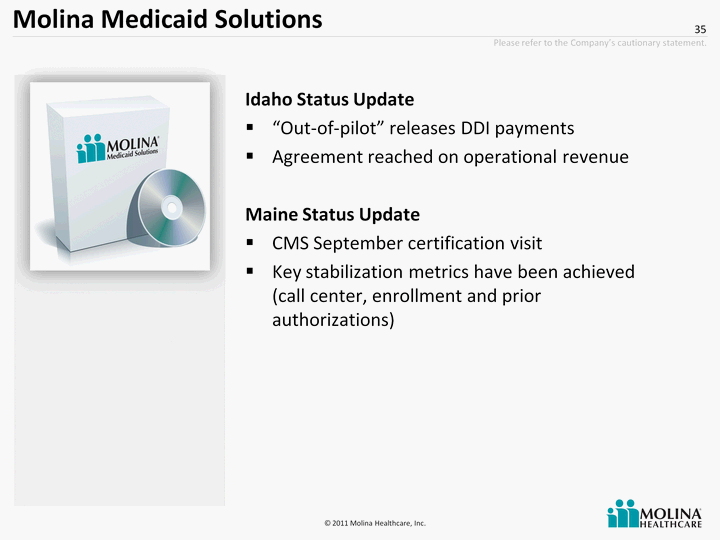
| Molina Medicaid Solutions Idaho Status Update "Out-of-pilot" releases DDI payments Agreement reached on operational revenue Maine Status Update CMS September certification visit Key stabilization metrics have been achieved (call center, enrollment and prior authorizations) 35 Please refer to the Company's cautionary statement. |
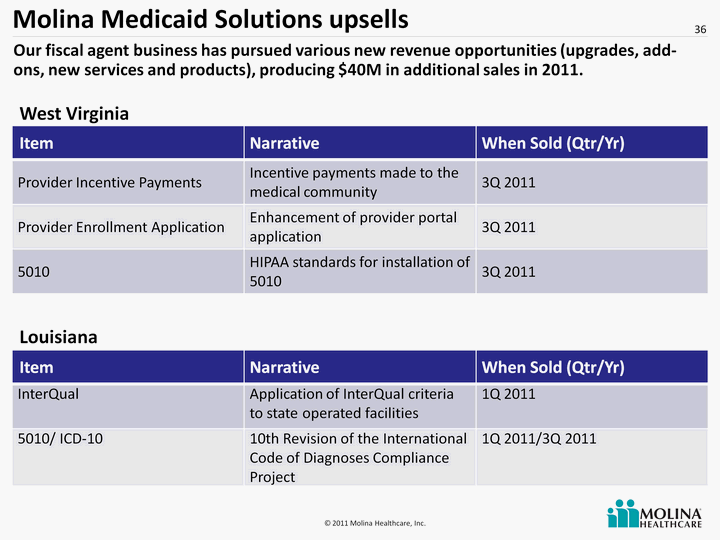
| Molina Medicaid Solutions upsells Molina Medicaid Solutions upsells 36 Item Narrative When Sold (Qtr/Yr) InterQual Application of InterQual criteria to state operated facilities 1Q 2011 5010/ ICD-10 10th Revision of the International Code of Diagnoses Compliance Project 1Q 2011/3Q 2011 West Virginia Louisiana Our fiscal agent business has pursued various new revenue opportunities (upgrades, add- ons, new services and products), producing $40M in additional sales in 2011. |
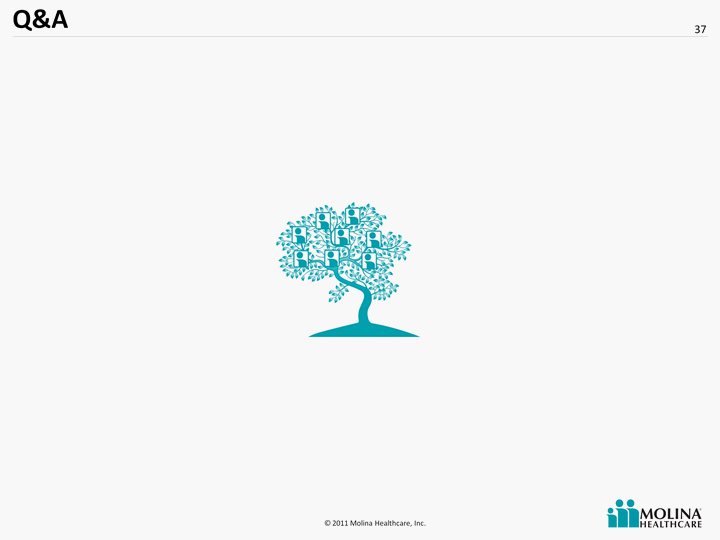
| Q&A 37 |

| New York, New York September 15, 2011 The Dual Eligible Opportunity J. Mario Molina, MD President & Chief Executive Officer |

| Unprecedented new focus on dual eligibles Recognition that duals are the most costly group of beneficiaries for both Medicaid and Medicare Duals account for approximately 15% of Medicaid enrollees but contribute to 39% of all Medicaid spending2 Medicaid/Medicare spending averages $20K per dual per year, 5X greater than other Medicare beneficiaries Dual population will highly benefit from managed care Nearly 9 million Medicaid beneficiaries are dual eligibles: low-income seniors and younger persons with disabilities who are enrolled in both the Medicare and Medicaid programs. 39 Source: 1. CMS Special Needs Plan Data https://www.cms.gov/MCRAdvPartDEnrolData/SNP/list.asp#TopOfPage 2. Kaiser Commission on Medicaid and the Uninsured, "Dual Eligbles" fact sheet, December 2010. http://www.kff.org/medicaid/upload/4091-07.pdf (CHART) Medicare Enrollment1 2008-YTD 2Q 2011 22K 18K 11K 6K 4K 7K 1K 1K 26K 25K 12K 7K |
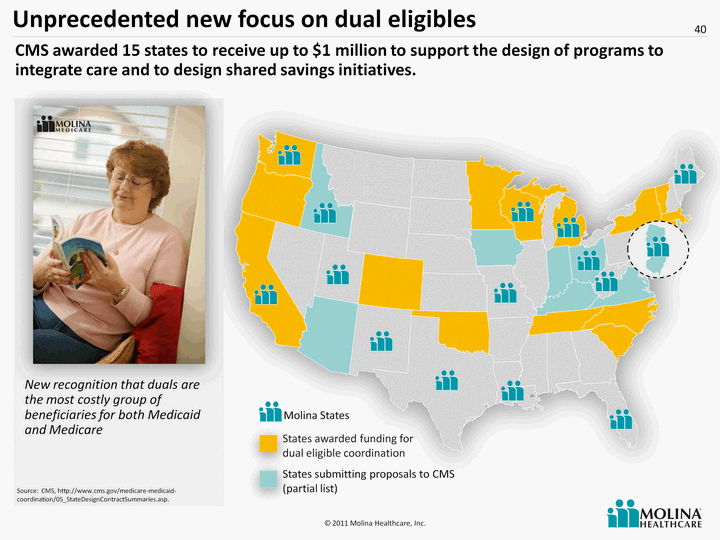
| CMS awarded 15 states to receive up to $1 million to support the design of programs to integrate care and to design shared savings initiatives. Unprecedented new focus on dual eligibles 40 Source: CMS, http://www.cms.gov/medicare-medicaid- coordination/05_StateDesignContractSummaries.asp. Molina States States awarded funding for dual eligible coordination New recognition that duals are the most costly group of beneficiaries for both Medicaid and Medicare States submitting proposals to CMS (partial list) |
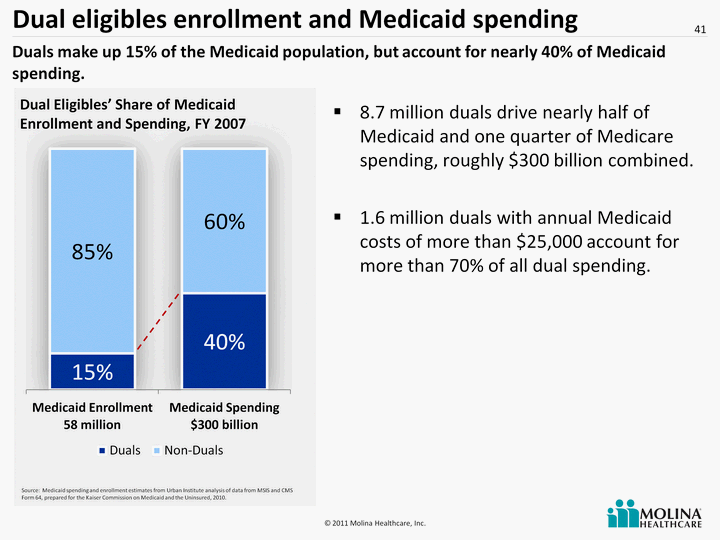
| Dual eligibles enrollment and Medicaid spending 8.7 million duals drive nearly half of Medicaid and one quarter of Medicare spending, roughly $300 billion combined. 1.6 million duals with annual Medicaid costs of more than $25,000 account for more than 70% of all dual spending. 41 (CHART) Dual Eligibles' Share of Medicaid Enrollment and Spending, FY 2007 Source: Medicaid spending and enrollment estimates from Urban Institute analysis of data from MSIS and CMS Form 64, prepared for the Kaiser Commission on Medicaid and the Uninsured, 2010. Duals make up 15% of the Medicaid population, but account for nearly 40% of Medicaid spending. |
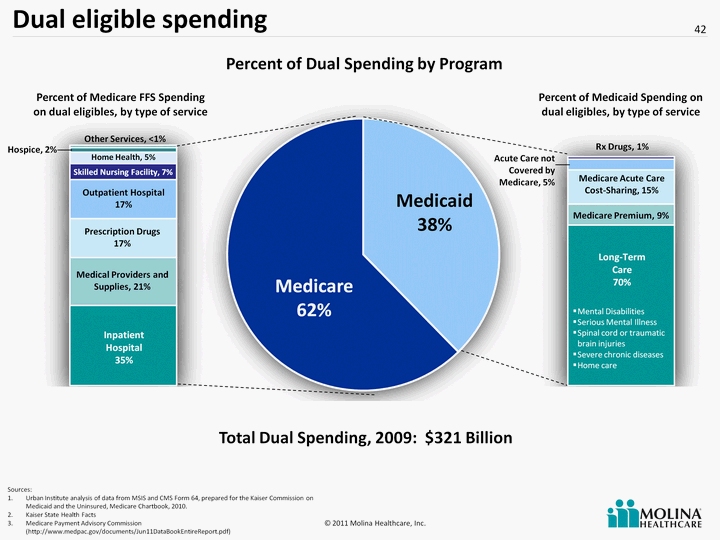
| Dual eligible spending 42 42 Sources: Urban Institute analysis of data from MSIS and CMS Form 64, prepared for the Kaiser Commission on Medicaid and the Uninsured, Medicare Chartbook, 2010. Kaiser State Health Facts Medicare Payment Advisory Commission (http://www.medpac.gov/documents/Jun11DataBookEntireReport.pdf) Medicare 62% Medicaid 38% (CHART) Rx Drugs, 1% Acute Care not Covered by Medicare, 5% Medicare Acute Care Cost-Sharing, 15% Medicare Premium, 9% Long-Term Care 70% Percent of Medicaid Spending on dual eligibles, by type of service Percent of Medicare FFS Spending on dual eligibles, by type of service Prescription Drugs 17% Home Health, 5% Hospice, 2% Percent of Dual Spending by Program Total Dual Spending, 2009: $321 Billion Mental Disabilities Serious Mental Illness Spinal cord or traumatic brain injuries Severe chronic diseases Home care |

| Dual eligibles 87% of duals have more than one chronic condition 70% of Medicaid spending on duals is for Long-Term Care (LTC) Molina's experience with LTC WMIP program since 2005 STAR+PLUS since 2008 Molina's SNP experience Molina's SNP dual eligible plan is ranked number 8 nationwide 43 |
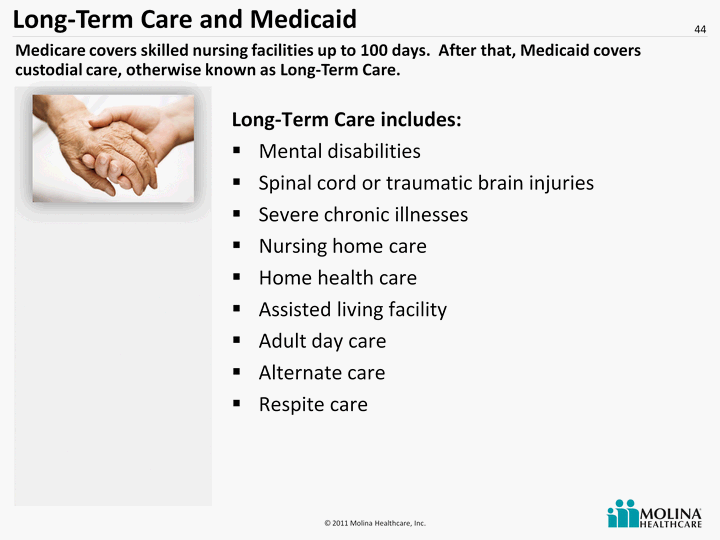
| Long-Term Care and Medicaid Long-Term Care includes: Mental disabilities Spinal cord or traumatic brain injuries Severe chronic illnesses Nursing home care Home health care Assisted living facility Adult day care Alternate care Respite care 44 Medicare covers skilled nursing facilities up to 100 days. After that, Medicaid covers custodial care, otherwise known as Long-Term Care. |
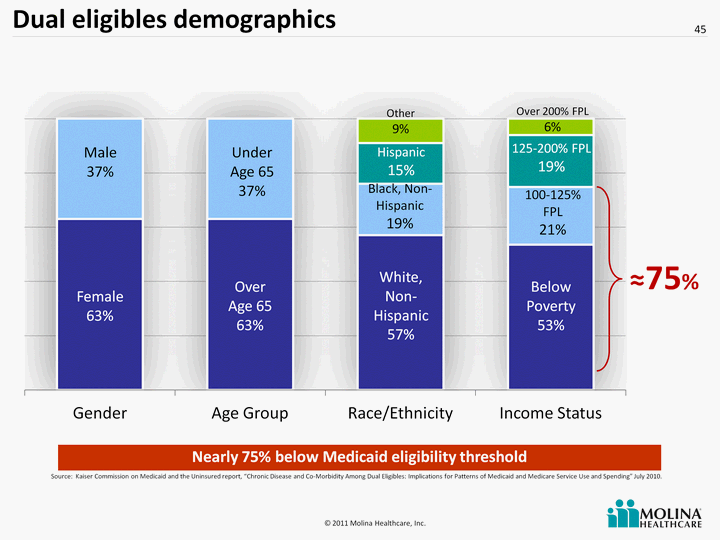
| Dual eligibles demographics 45 Source: Kaiser Commission on Medicaid and the Uninsured report, "Chronic Disease and Co^Morbidity Among Dual Eligibles: Implications for Patterns of Medicaid and Medicare Service Use and Spending" July 2010. (CHART) Female 63% Male 37% Over Age 65 63% Under Age 65 37% Below Poverty 53% 100-125% FPL 21% 125-200% FPL 19% Over 200% FPL 6% Other 9% Hispanic 15% Black, Non- Hispanic 19% White, Non- Hispanic 57% Nearly 75% below Medicaid eligibility threshold ^75% |

| Dual eligibles in Molina states 46 46 Source: CMS Fact Sheet, "People Enrolled in Medicare and Medicaid," May 2011. Approximately 40% of all duals in the United States reside in Molina states. Established programs position Molina to serve duals |
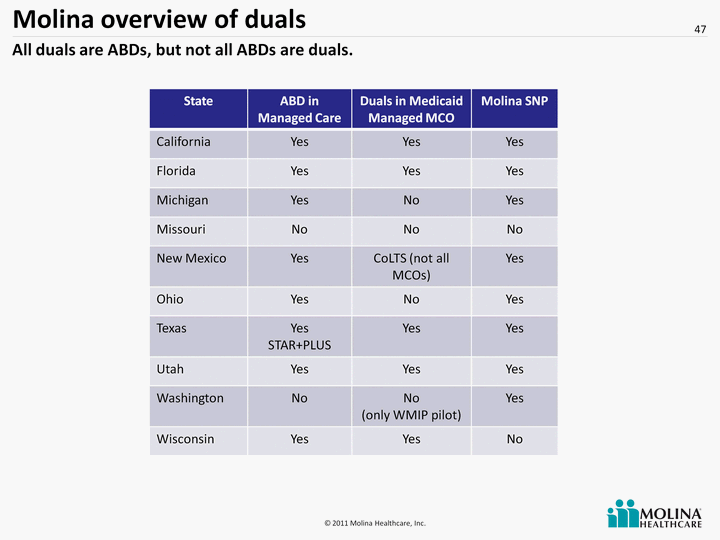
| Molina overview of duals Molina overview of duals 47 All duals are ABDs, but not all ABDs are duals. |
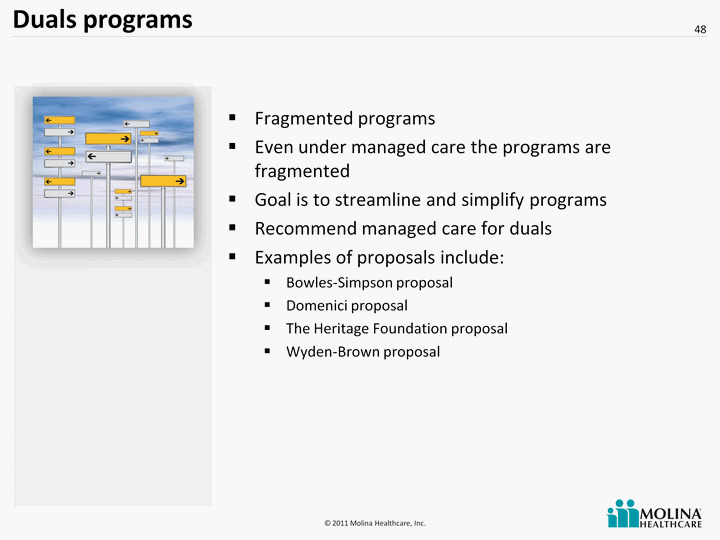
| Duals programs Fragmented programs Even under managed care the programs are fragmented Goal is to streamline and simplify programs Recommend managed care for duals Examples of proposals include: Bowles-Simpson proposal Domenici proposal The Heritage Foundation proposal Wyden-Brown proposal 48 |
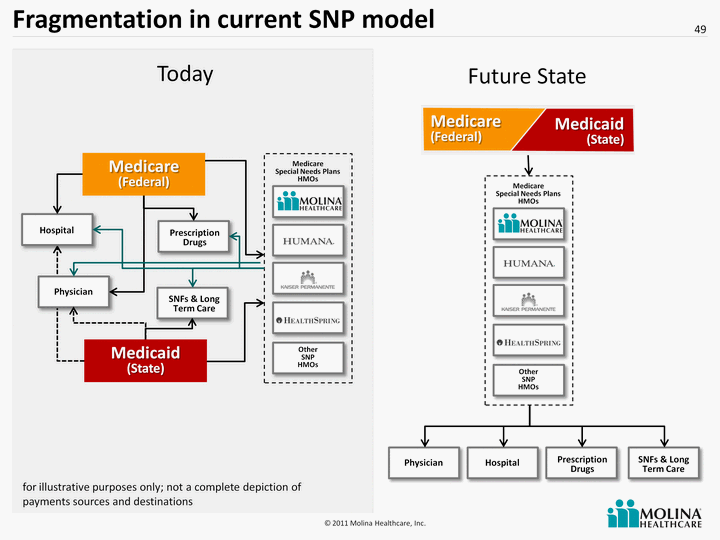
| Fragmentation in current SNP model 49 Medicare (Federal) Medicare Special Needs Plans HMOs Other SNP HMOs Prescription Drugs Physician Hospital SNFs & Long Term Care Medicaid (State) Medicare Special Needs Plans HMOs Other SNP HMOs Medicare (Federal) Medicaid (State) Prescription Drugs Physician Hospital SNFs & Long Term Care for illustrative purposes only; not a complete depiction of payments sources and destinations Today Future State |
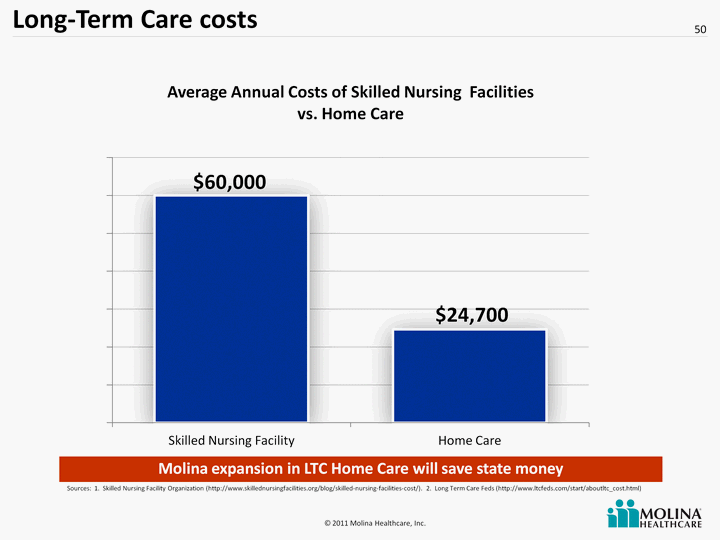
| Long-Term Care costs 50 Sources: 1. Skilled Nursing Facility Organization (http://www.skillednursingfacilities.org/blog/skilled-nursing-facilities-cost/). 2. Long Term Care Feds (http://www.ltcfeds.com/start/aboutltc_cost.html) Average Annual Costs of Skilled Nursing Facilities vs. Home Care (CHART) Molina expansion in LTC Home Care will save state money |

| Dual eligible care coordination Coordinating Medical Care Allows states to choose the locus and level of integration that meets their needs and goals Capitated models provide states greater budget predictability (although consideration needs to be given to the degree of financial risk) Allows for some streamlining of administrative processes (e.g., enrollment, marketing, quality measures and reports, etc.) SNPs are required to have a multi-disciplinary care team that works together to develop individual care plans for beneficiaries 51 LTC Duals ABD TANF complexity of care Number of potential enrollees Molina has extensive experience in coordinating care Source: Molina Healthcare's Investor Day, May 2008. |
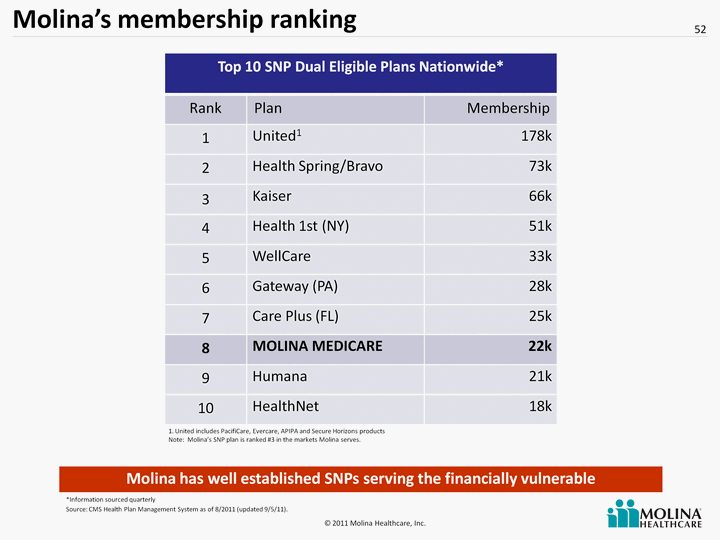
| Molina's membership ranking 52 *Information sourced quarterly Source: CMS Health Plan Management System as of 8/2011 (updated 9/5/11). Top 10 SNP Dual Eligible Plans Nationwide* Top 10 SNP Dual Eligible Plans Nationwide* Top 10 SNP Dual Eligible Plans Nationwide* Rank Plan Membership 1 United1 178k 2 Health Spring/Bravo 73k 3 Kaiser 66k 4 Health 1st (NY) 51k 5 WellCare 33k 6 Gateway (PA) 28k 7 Care Plus (FL) 25k 8 MOLINA MEDICARE 22k 9 Humana 21k 10 HealthNet 18k Molina has well established SNPs serving the financially vulnerable 1. United includes PacifiCare, Evercare, APIPA and Secure Horizons products Note: Molina's SNP plan is ranked #3 in the markets Molina serves. |
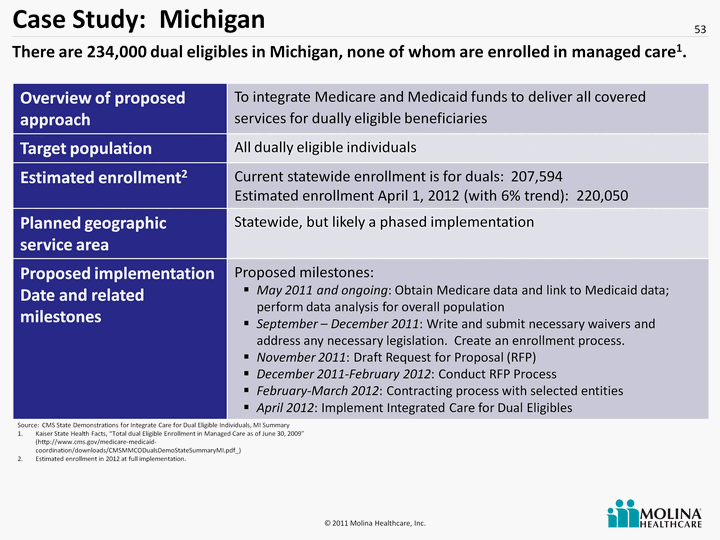
| Case Study: Michigan Case Study: Michigan 53 Source: CMS State Demonstrations for Integrate Care for Dual Eligible Individuals, MI Summary Kaiser State Health Facts, "Total dual Eligible Enrollment in Managed Care as of June 30, 2009" (http://www.cms.gov/medicare-medicaid- coordination/downloads/CMSMMCODualsDemoStateSummaryMI.pdf_) Estimated enrollment in 2012 at full implementation. There are 234,000 dual eligibles in Michigan, none of whom are enrolled in managed care1. |
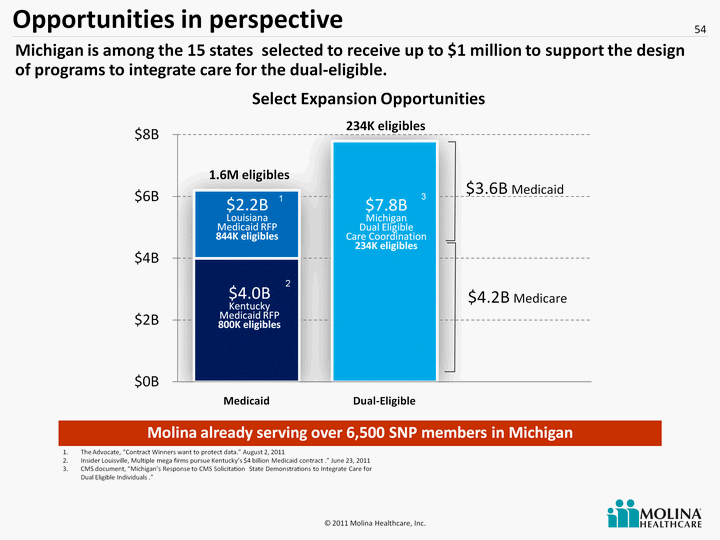
| Opportunities in perspective 54 (CHART) $4.0B Kentucky Medicaid RFP 800K eligibles $2.2B Louisiana Medicaid RFP 844K eligibles $7.8B Michigan Dual Eligible Care Coordination 234K eligibles $3.6B Medicaid $4.2B Medicare The Advocate, "Contract Winners want to protect data." August 2, 2011 Insider Louisville, Multiple mega firms pursue Kentucky's $4 billion Medicaid contract ." June 23, 2011 CMS document, "Michigan's Response to CMS Solicitation State Demonstrations to Integrate Care for Dual Eligible Individuals ." Michigan is among the 15 states selected to receive up to $1 million to support the design of programs to integrate care for the dual-eligible. Select Expansion Opportunities 1 2 3 Molina already serving over 6,500 SNP members in Michigan 1.6M eligibles 234K eligibles |
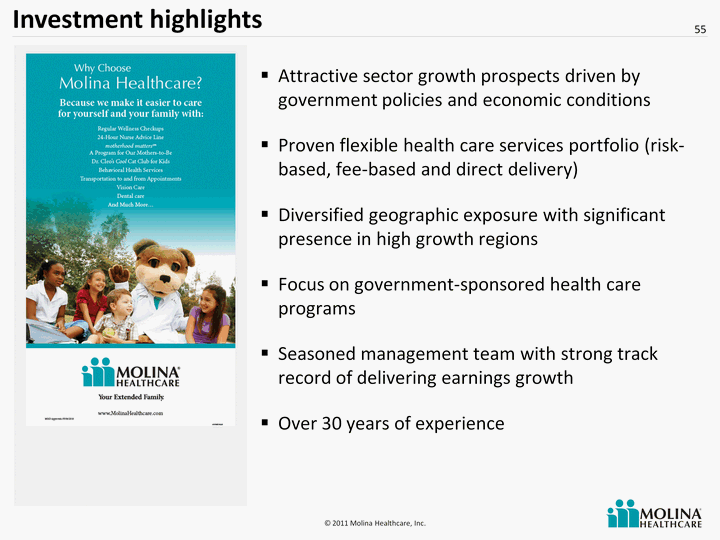
| Investment highlights Attractive sector growth prospects driven by government policies and economic conditions Proven flexible health care services portfolio (risk- based, fee-based and direct delivery) Diversified geographic exposure with significant presence in high growth regions Focus on government-sponsored health care programs Seasoned management team with strong track record of delivering earnings growth Over 30 years of experience 55 |

| Q&A 56 |
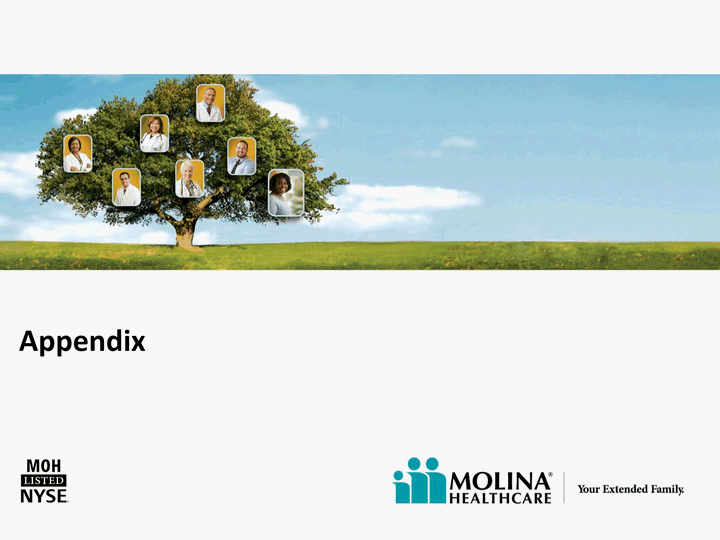
| Appendix |

| Reconciliation of Non-GAAP to GAAP Financial Measures (1) GAAP stands for U.S. generally accepted accounting principles. (2) We calculate EBITDA consistently on a quarterly and annual basis by adding back depreciation and amortization to operating income. Operating income includes investment income. EBITDA is not prepared in conformity with GAAP because it excludes depreciation and amortization, as well as interest expense, and the provision for income taxes. This non-GAAP financial measure should not be considered as an alternative to the GAAP measures of net income, operating income, operating margin, or cash provided by operating activities, nor should EBITDA be considered in isolation from these GAAP measures of operating performance. Management uses EBITDA as a supplemental metric in evaluating our financial performance, in evaluating financing and business development decisions, and in forecasting and analyzing future periods. For these reasons, management believes that EBITDA is a useful supplemental measure to investors in evaluating our performance and the performance of other companies in our industry. Please refer to the Company's cautionary statement. |
